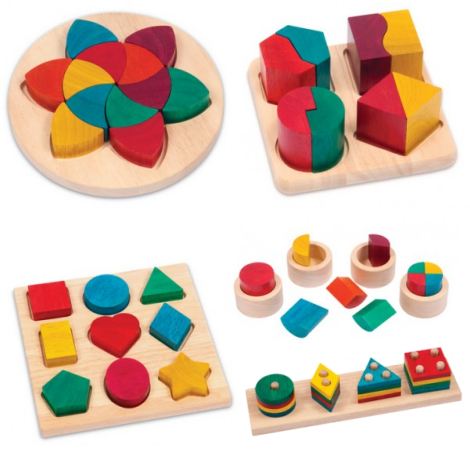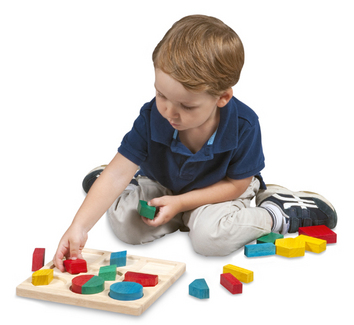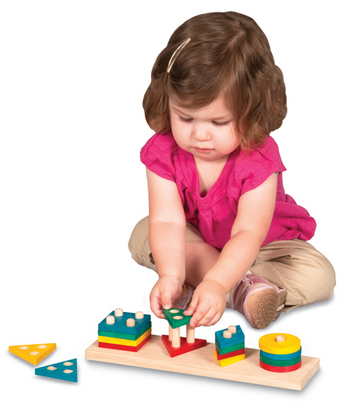
Guidecraft sent me an assortment of their Montessori-style wooden puzzles and the entire family is impressed!
The children immediately begged me to open all the puzzles but I parceled them out over several weeks so that they would have a chance to more fully explore each one.
Because the puzzles are open-ended, the educational potential of these puzzles is limitless. Whether you are studying basic concepts, such as shapes, colors, relative size, or counting, or more advanced concepts, such multiplication or fractions, there are plenty of play possibilities to engage your child. Plus, the puzzles encourage creative problem solving, spatial relations, and fine motor control.
When my mother, a former special education teacher, saw them she exclaimed, “Where did you get those beautiful puzzles?”
Made from eco-friendly rubberwood and stained with colorful low VOC aniline dyes, these puzzles encourage children to pick up the pieces and play.
Each puzzle comes with a booklet of play suggestions to help you guide your child in educational play.
There are two basic reasons why these puzzles work so well, besides the fact that they are just plain fun!
First, is the “tell me and I’ll forget, show me and I’ll remember, involve me and I’ll understand” principle. Math manipulatives help children understand high-level concepts in an intuitive way. The physical experience of playing with the pieces of the puzzles engraves the idea into the child’s worldview.
The other is the “Velcro theory” knowledge acquisition. Later, when the child is studying these ideas in a more formal way, the academic terminology and concepts will “stick” to the prior experience–just like Velcro.

At the most basic level, you can ask your child to hand you objects of certain colors or shapes or group these objects together to learn categorization. I even use exercises like this with middle school students learning how to organize information for writing essays!
The Fraction Cups and Fraction Action Board help children see that any whole can be divided into halves, thirds, and quarters.
And take the four triangle shapes with three holes out of the One to Four Sorter and count the number of holes, total. Three times four is twelve–your child is multiplying!
 You get a lot of play value for your dollar with these puzzles. They will last through several children, who will be able to learn with them for years. And then you can pass them along to the grandchildren or donate them to your school to instill a love of learning in future generations!
You get a lot of play value for your dollar with these puzzles. They will last through several children, who will be able to learn with them for years. And then you can pass them along to the grandchildren or donate them to your school to instill a love of learning in future generations!
Whether they are playing with them with me or independently, my children are fascinated by these puzzles.
—
WANT IT: Purchase these wooden puzzles on Guidecraft ($25 each).
WIN IT: Head over to Teach Preschool for a Guidecraft Giveaway of these puzzles! (Please note there is no giveaway for this item on Mamanista.)
—
Disclaimer: As one of Guidecraft’s Educator Bloggers, I am receiving products for review. My opinions are my own based on my experiences with my children and my knowledge as an educational consultant.
